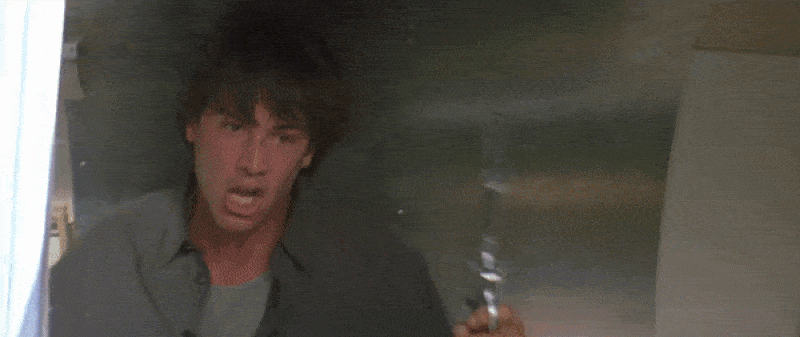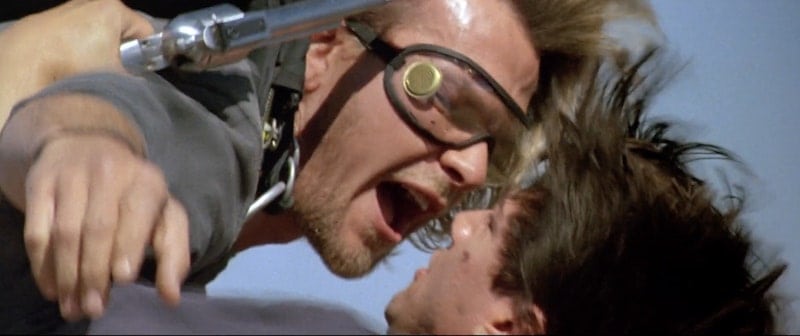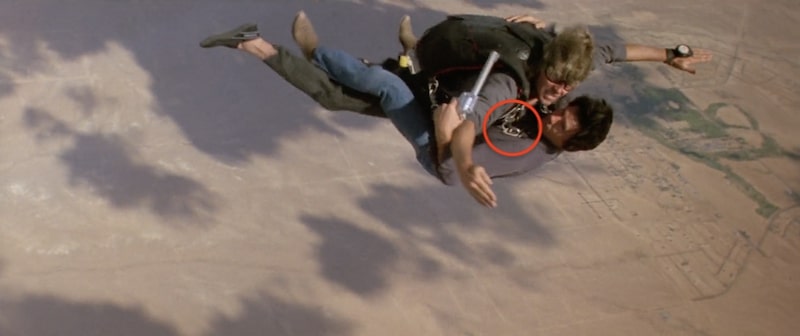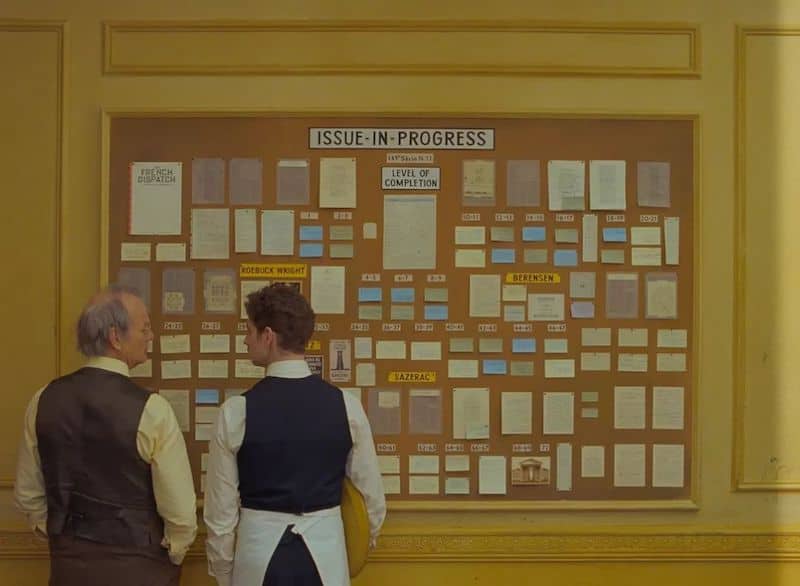How They Shot the No Parachute Skydiving Scene in ‘Point Break’

Welcome to How’d They Do That? — a monthly column that unpacks moments of movie magic and celebrates the technical wizards who pulled them off. This entry explains how they shot the parachute-less skydiving scene in Kathryn Bigelow’s Point Break.
What’s better than this, guys being dudes who rob banks wearing rubber masks of ex-presidents to fund surfing adventures?
Indeed, there are few things better than Point Break. The 1991 cult hit enthusiastically melds cops-and-robbers action with reverential depictions of extreme sports and male bonding. It’s a “wet Western” and one of the greatest female-gaze action movies ever made. Do try and refrain from high-fiving your nearest bro as I recount the plot:
The film follows Johnny Utah (Keanu Reeves), a newly-minted FBI agent assigned to infiltrate an outlaw surfer gang led by the guru-like Bodhi (Patrick Swayze). Utah’s straightlaced ethics fray as Bodhi sways him with the adrenaline-seeking lifestyle, a spiritual pursuit that opens Utah’s eyes to the possibility that there might be more to life than following orders. Utah is pulled into a world and lifestyle in diametric opposition to his own, just as the film’s presumed cops-and-robbers plot is forced to contend with the contagious good vibes of the surf and the sky. As director Kathryn Bigelow relays in a 1991 interview with The Guardian’s Mark Salisbury, Point Break’s power (narrative and otherwise) rests on the ideological tension between its two leads: “when your good guy—your hero—is seduced by the darkness inside him and your villain is no villain whatsoever.”
While Utah wrestles with his double life, we are treated to some of the most engaging extreme sports sequences to grace the silver screen. There are not one but two skydiving scenes in Point Break. In the first, Utah (who rightfully suspects his cover is blown) is whisked away on an early morning jump with the boys. His paranoia quickly shifts to joining hands in the middle of the sky, setting aside all differences to enjoy the rush of freefall.
The second skydiving sequence takes place under less harmonious circumstances. After the FBI arrests Utah for his apparent involvement in a bank robbery, he is released by his partner (Gary Busey) and dropped off at an airport to catch Bodhi. A shootout ensues, and Utah follows Bodhi aboard a plane bound for Mexico. At the appointed time, Bodhi and his last remaining (and barely alive) henchman hop out of the plane in parachutes, leaving Utah with nothing but a gun and a tough choice: to jump or not to jump?

To jump. Utah hurtles out of the plane without a parachute. He catches up and latches onto Bodhi, who is bemused at this absolutely radical turn of events. In freefall, the pair enter into a standoff: Bodhi refuses to release their now shared parachute, but to pull the cord himself, Utah will have to drop his gun. With seconds to spare, Utah drops his firearm and releases the parachute. The impact is hard, but busted knee be damned, Utah is lucky to be alive.
I’ll freely admit to letting loose an “oh, shit” the first time I saw Utah jump. And if you, too, were fully in the moment, free from intrusive thoughts about what the laws of physics have to say about all of this, you may very well have done the same. But how on earth did they film this? How could they do something like that and keep insurance rates within the realm of reason? What’s real, what’s fake, and how did Bigelow and company martial movie magic to make it look like two of the biggest stars in Hollywood were plummeting through the sky?
How’d they do that?
Long story short:
This sequence in Point Break combines an actual skydiving jump by Patrick Swayze, stunt doubles, and close-up insert shots of Swayze and Keanu Reeves filmed on a skydiving simulation rig.
Long story long:
The best way to appreciate Point Break’s sans-parachute skydiving scene is to move through it (relatively) shot-by-shot.
The sequence begins in earnest when Bodhi salutes Utah and, looking straight down the camera, signs off with an “adios amigo” and jumps backward out of the plane. The unbroken take lasts almost ten whole seconds. And the whole point of doing the jump backward is to show you, the audience, that movie star Patrick Swayze really did just jump out of a plane.
Accounts from skydiving forms suggest that Swayze learned how to skydive over the course of the shoot. This must have delighted Swayze’s younger brother, Don, a regular at Perris Valley Skydiving with well over 500 jumps to his name. According to folks like USA Today’s Karen Thomas, Swayze made around 50 jumps total over the course of the production. It’s unclear if this number refers to his recreational jumps or the jumps he performed that wound up in the final film.
Speaking of Swayze’s recreational skydiving, the studio was not super pleased about their big star’s newfound hobby, which they saw as an insurance liability. After being told off for jumping in his spare time (supposedly dragging Busey along with him at one point), a deal was struck: if Swayze stopped skydiving recreationally, he’d be allowed to do a big jump for the movie. It’s unclear if Swayze made good on his half of the bargain. But if he did sneak around behind the producers’ backs, you can kind of see why. “I had to battle insurance companies to get to do the skydiving in the movie and never came close to dying once,” the actor remembers in “It’s Make Or Break,” the film’s behind-the-scenes featurette. “But they never said one word about me getting my brains pounded in by the biggest surf on this planet.”

After Swayze plummets (for real) to earth, we cut back to Utah inside the plane. If I had to venture a guess, I’d imagine these shots were filmed while grounded, given the camera placement and the suspiciously obfuscating exposure outside of the cabin. Reeves is likely swan diving onto a crash mat.
Next, we cut to Reeves’ stunt double (possibly Pat Banta) diving through the air, apparently without a parachute. However, as professional skydiver Jeb Corliss points out in this video for GQ, if you look closely, you can see that the stuntman has a hidden rig under his shirt, which will break off and open up to allow the parachute to do its thing.
Shots of Reeves’ stunt double doing a real jump are intercut with closeups of Reeves himself seemingly plummeting through the air. To achieve close-ups of the core actors during both skydiving sequences, the production built a special crane rig that held the actors in the air, approximately 10 feet off the ground. As Swayze explains on the DVD featurette, the rig featured a telescoping arm for each actor in the shot, allowing them to move independently of each other, in and out of frame. “They built a body thing with a post coming out of the center of it. We laid in that and you strapped yourself in and put your clothes on over it.”
The illusion was tied together with a lot of high-powered fans to simulate wind. And as second unit director/stunt coordinator Glenn R. Wilder puts it in “It’s Make or Break”: “the secret was to also float the camera…we had it so that we could turn and oscillate, and it worked out very well.” The rig enabled the actors to say their lines while the camera shot them from below and to the side to give the illusion of floating while skydiving.
Speaking of…well…speaking, after a couple of cuts between the rig closeups and the real jump footage, Utah finally catches up to Bodhi and latches on. If you’re a fan of “hey, that’s a stunt double” freeze-framing, you’ll get a real kick out of this shot sequence. Also, for those wondering, this beat in the stunt is, in fact, physically doable. On an airplane-themed episode of MythBusters, it was determined that it is, in fact, possible to catch up to someone with a 15-second head start by streamlining your body. Meanwhile, free falling for 90 seconds from 4,000 feet is, sadly, busted.

In any case, once our duo is koala-ing in the sky, all realism evaporates. In a close-up (shot on the rig), Utah and Bodhi have a heated debate about who will pull the parachute cord (“the ultimate game of chicken,” as Reeves put it during a 1991 interview with Good Morning America). As Swayze himself puts it in the featurette: “you can’t talk in free fall. You’ve got 120 to 200 mile an hour winds which is nothing but a giant roar. So there is a little bit of poetic license taken with us having conversations.” During the “ultimate game of chicken,” the camera cuts sporadically to wide shots of the two stunt jumpers locked together. This is a good opportunity to point out that stunt Utah and Bodhi are almost certainly strapped into each other’s rigs. As Corliss notes in the aforementioned GQ video, it’s physically impossible (though he has tried) to hold onto someone “manually” in this scenario. This could explain why the pair drift out of frame when Utah ultimately pulls the cord; to disguise what would be an obvious lurch resulting from the two interlocked parachute rigs.

I spy with my little eye two interlocked parachute clips.
The vast majority of the film’s aerial photography was captured by Tom Sanders and his mentor Ray Cottingham under the direction of second unit director/accomplished skydiver Kevin Donnelly. In an interview with Skydive Perris, Sanders recalls that while Swayze had two stunt doubles for the jumps, “he definitely did some of the jumping that is in the final cut.” Much of this, I would imagine, is included in the first skydive sequence, including footage Swayze and Sanders shot on their own after the skydiving scenes had wrapped “to make the scene better.”
Dave Donnelly (son of Kevin) was only 16 years old skydiving virgin when he worked on Point Break as a parachute packer and gopher (as in: go f’er coffee). As Donnelly relays in an interview with Skydive Perris, the Mexico-set sequence was actually shot at the Cal City Parachute Center in the Mojave desert. It was early August and well over 100°F (38°C). “For the shot we were working on, the stunt doubles would exit the aircraft with a helicopter flying left trail. A Twin Otter [a kind of plane] had a camera crew shooting out of the side door and zooming in [on] the doubles [as] they fell away from the camera.” Donnelly goes on to describe how on the third day of shooting, an accident took place where the helicopter hit the plane, forcing everyone (including crewmembers who just wanted to cool off in the sky who had no skydiving experience) to jump out. The damaged plane landed without incident, but “the helicopter was in much worse shape…I was happy to eventually learn that everyone survived.”
The sequence wraps up with Bodhi and Utah miraculously surviving. I say “miraculously” because, as Katherine Davies points out in a journal article for the University of Leicester, for the pair to land safely after only pulling their parachute 8 seconds before landing, the cross-sectional area would have to be 641.7 square feet, a.k.a. four times larger than a normal skydiving parachute. In actuality, the pair’s crash landing was likely achieved with a simple out-of-frame drop and some very hardy stunt performers.
What’s the precedent?
I’d be remiss not to mention 1969’s The Gypsy Moths, a film by John Frankenheimer (yes, that John Frankenheimer) about a skydiving team who become embroiled in the interpersonal shenanigans of a small Kansas town during the Fourth of July.
The Gypsy Moths isn’t just a cinematic precedent for Point Break, but a visual artifact of the precedent for skydiving, full stop. The film highlights the sport’s infancy, long before it became commercialized, and even features the earliest blueprints for what would become the wingsuit. Carl Boenish and Jay Gifford captured the film’s aerial photography, a task that included filming the jumps with a 35 mm camera mounted on their helmets.
But really, when it comes to cinematic skydiving scenes where someone jumps out of a plane without a parachute, Point Break owes a massive amount of credit is due to 1979’s Moonraker. In the film’s opening scene, 007 (Roger Moore) is shoved out the door of a plane by the towering, metal-mouthed henchman Jaws (Richard Kiel) without a parachute. Thinking fast, Bond streamlines his way to a different henchman, skydiving below him. A mid-air scuffle ensues, and Bond steals the poor man’s parachute for himself. Jaws follows and tries to bite Bond’s ankles (no really), only for Bond to pull his cord, pulling him upwards and out of reach.
Shot in California and coordinated by Don Calvedt under the supervision of second unit director/editor John Glen, the sequence took an intense amount of planning and collaboration with skydivers and stuntmen like B.J. Worth (who played the treacherous pilot whose parachute Bond steals) and Jake Lombard (Moore’s aerial stunt double). Ron Luginbill stood in (or is that jumped in?) for Jaws. The planning process included developing a 1 inch-thick parachute pack that could be concealed within Lombard’s suit and velcro-tear away costumes that allowed the hidden parachutes to open. The scene took a total of 88 jumps to capture, with in-studio closeups from Moore and Kiel made possible by our good old friend: rear projection.
Hey, does anyone else really want to go skydiving now?





